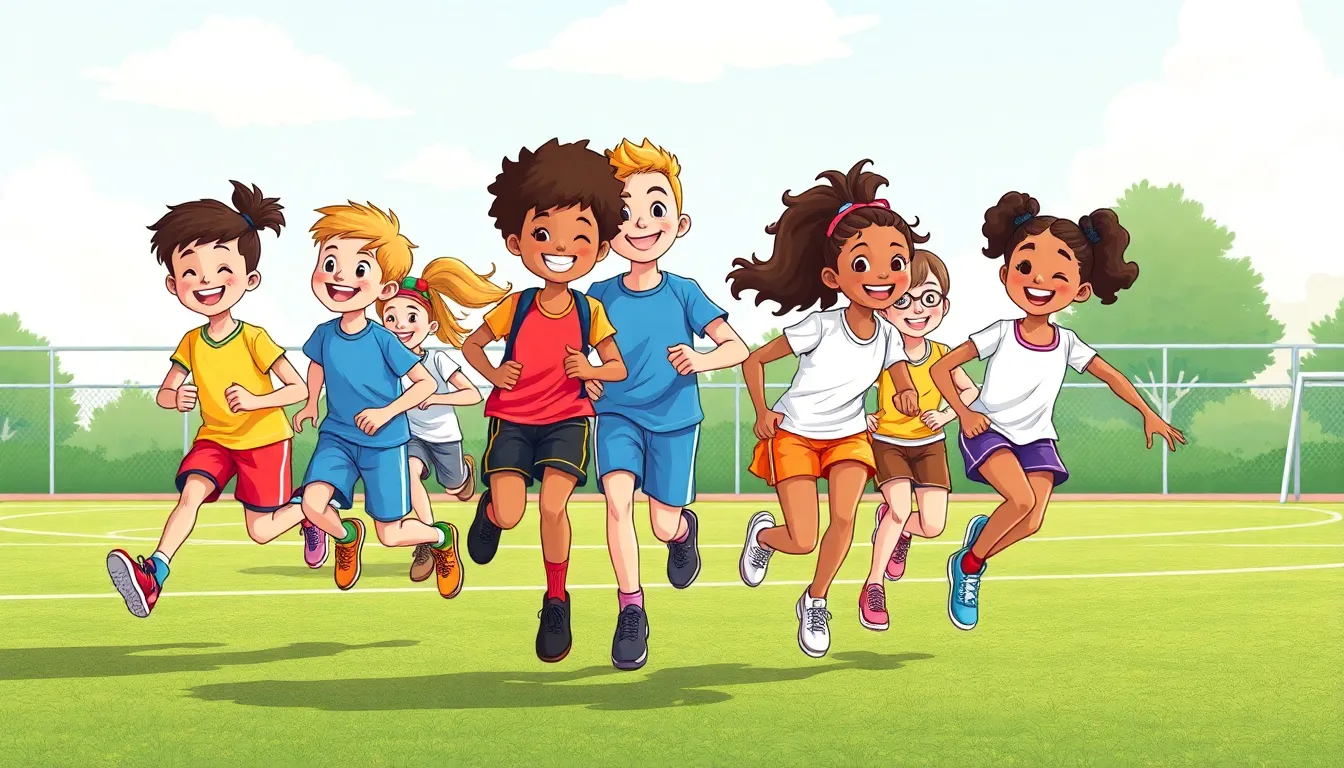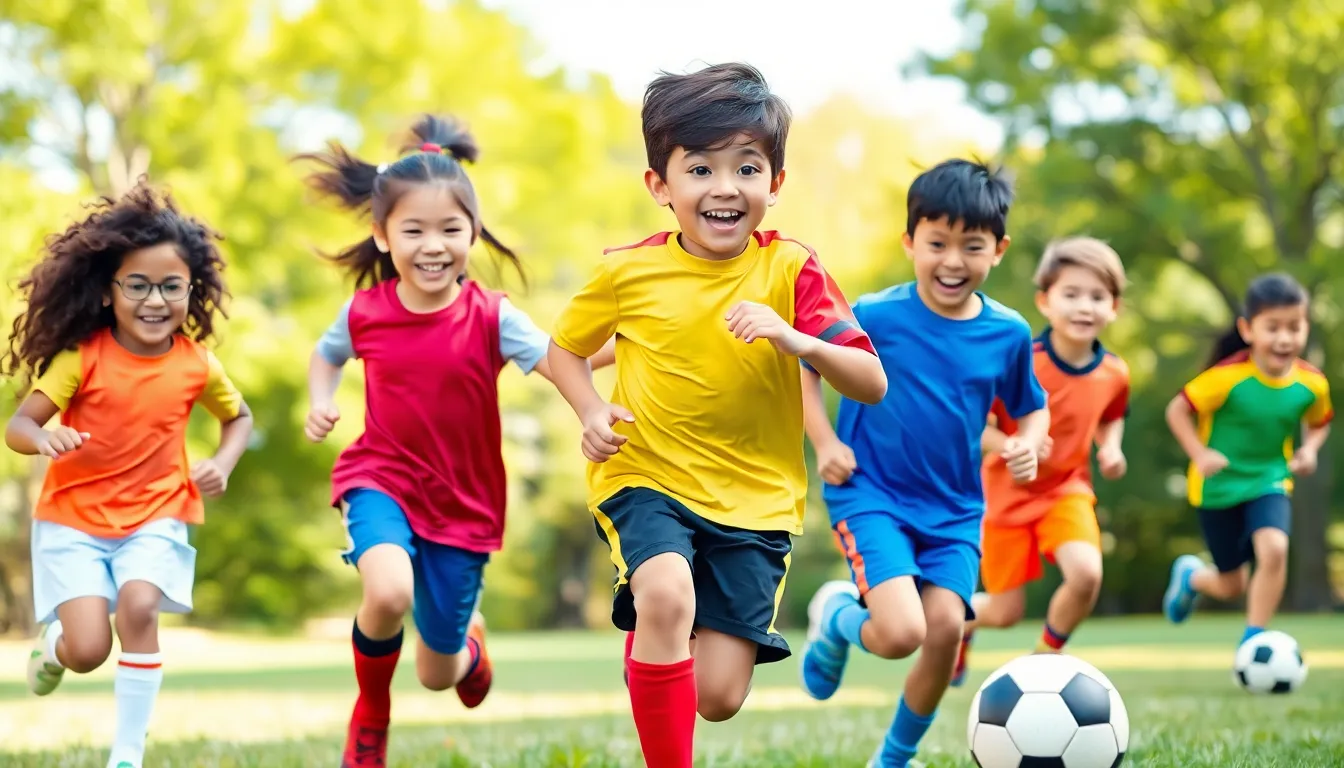Table of Contents
ToggleIn a world where kids are glued to screens, children’s athletics offers a refreshing escape into the great outdoors. Imagine your little ones trading video game marathons for sprints, jumps, and friendly competitions. Not only does this keep them active, but it also helps them develop essential life skills like teamwork and resilience. Who knew running around could be so beneficial?
Overview of Children’s Athletics
Children’s athletics involves physical activities that encourage children to engage in sports from a young age. Participation in sports promotes physical fitness and develops essential skills that benefit children in various aspects of life. By fostering teamwork, children learn how to work collaboratively with peers. They also develop resilience through challenges encountered in competitive settings.
Various sports cater to young athletes, including soccer, basketball, swimming, and track and field. Each sport offers unique benefits that contribute to children’s overall development. For instance, soccer enhances cardiovascular fitness while improving coordination and agility. Swimming builds endurance and can also serve as a vital lifesaving skill.
Organizations across the country promote children’s athletics, emphasizing inclusivity and accessibility. Community programs provide opportunities for children from diverse backgrounds to participate in sports. These initiatives help develop a sense of belonging and community among young athletes.
In addition to physical benefits, participation in athletics enhances social skills. Children learn to communicate effectively, understand their roles in a team, and celebrate others’ successes. These interactions contribute to strong friendships that can last a lifetime.
Health organizations encourage parents to support their children’s involvement in sports. Engaging children in athletics establishes healthy habits early, potentially reducing the risk of obesity and related health issues. Establishing a routine of regular exercise supports lifelong wellness, instilling values of perseverance and discipline.
Research indicates that children who engage in athletics perform better academically. They often demonstrate improved concentration, better time-management skills, and enhanced self-esteem. Prioritizing athletics can thus lead to a well-rounded and successful upbringing.
Benefits of Children’s Athletics

Children’s athletics offer numerous advantages that significantly contribute to their growth and development.
Physical Development
Participation in sports enhances children’s physical development. Engaging in activities like running and jumping builds strength, coordination, and endurance. Regular exercise fosters a healthy lifestyle and helps maintain a healthy weight. Research indicates that children involved in athletics demonstrate improved cardiovascular health and motor skills. Sports also encourage better sleep patterns and boost overall energy levels. Furthermore, diverse sports teach children how to balance competition and enjoyment, creating a positive association with physical activity.
Social Skills
Athletics provide a unique platform for developing essential social skills. Interactions on teams foster cooperation and communication, helping children learn how to work with peers towards common goals. Long-lasting friendships often form through shared experiences in sports. Children also develop conflict-resolution skills while navigating challenges on the field or court. These social interactions contribute to a sense of belonging within the community, enhancing overall emotional well-being. Encouragement from coaches and teammates bolsters self-confidence and reinforces positive social behaviors.
Mental Health
Involvement in athletics plays a crucial role in promoting mental health among children. Regular physical activity reduces symptoms of anxiety and depression, leading to improved mood and emotional stability. Participation in team sports enhances resilience as children face wins and losses together. Furthermore, staying active strengthens focus and concentration, which translates into academic success. Research shows children engaged in athletics often exhibit higher self-esteem and a greater sense of purpose. Coaches and positive role models within sports create supportive environments that foster mental well-being.
Types of Children’s Athletics Programs
Children’s athletics programs encompass a wide range of activities, supporting physical development and social skills. Various programs cater to individual preferences and strengths, fostering a love for movement through structured opportunities.
Individual Sports
Individual sports promote self-reliance and personal achievement. Activities like gymnastics, swimming, and tennis encourage children to set personal goals. In gymnastics, athletes develop flexibility and strength while focusing on individual routines. Swimming enhances cardiovascular fitness and builds endurance through personal milestones. Tennis teaches strategy and concentration, requiring players to navigate matches alone. Skills such as discipline emerge as youngsters practice independently, fostering a robust sense of self-confidence.
Team Sports
Team sports focus on collaboration and communication among peers. Popular options include soccer, basketball, and volleyball, where teamwork is pivotal for success. Soccer teaches players to work together strategically, enhancing field awareness and coordination. Basketball improves hand-eye coordination while promoting shared objectives. Volleyball builds interpersonal skills, as team members rely on each other during matches. These experiences cultivate friendships and instill values of cooperation, helping children understand the importance of working toward a common goal.
Challenges in Children’s Athletics
Children’s athletics face several challenges that can impact their participation and overall experience in sports. Addressing these challenges is essential for fostering a safe and inclusive environment in children’s athletics.
Safety Concerns
Safety remains a primary issue in children’s athletics. Injuries can result from inadequate supervision, improper training, or lack of appropriate safety gear. Many organizations recommend age-appropriate programs that focus on skill development and injury prevention. Coaches need training to recognize and address potential hazards. Parents should ensure athletes wear the proper equipment, such as helmets and pads in contact sports. Establishing first aid protocols is crucial for handling emergencies effectively.
Inclusivity
Inclusivity in children’s athletics promotes participation from diverse backgrounds. Programs that embrace all children foster a sense of belonging and enhance social interactions. Existing structures often exclude kids with disabilities, limiting their opportunities for athletic engagement. Sports organizations increasingly prioritize adaptive sports to accommodate varying abilities. Combining youth from different cultures in team settings enriches experiences and broadens perspectives. Ultimately, promoting inclusivity aligns with community values and encourages lifelong engagement in sports.
Trends in Children’s Athletics
Recent developments show a significant shift in children’s athletics, emphasizing integration and innovation.
Technology in Training
Innovations in technology enhance training methods for young athletes. Wearable fitness trackers monitor performance metrics, allowing coaches to customize training plans based on individual needs. Video analysis software helps athletes refine techniques by providing instant feedback. Mobile applications offer engaging workout routines, increasing motivation among children to stay active. Virtual coaching programs expand accessibility, bringing expert guidance to remote locations. Enhanced gaming experiences promote physical activity through interactive play, merging entertainment with fitness.
Youth Sports Organizations
Youth sports organizations play a crucial role in promoting athletics among children. Programs focus on inclusivity, offering opportunities for participation across various skill levels. Community-based leagues establish strong social networks, fostering connections among families and reinforcing a sense of belonging. National organizations implement standardized safety protocols to ensure participants’ well-being. Additionally, they provide resources for coaches, helping them develop skills to support diverse athletes. Scholarships and funding initiatives help underprivileged children access training and competitions, making athletics more accessible to everyone.
Children’s athletics play a vital role in shaping healthier and happier lives. By participating in sports, kids not only enhance their physical fitness but also develop crucial social skills and emotional resilience. The benefits extend beyond the field, positively impacting academic performance and overall mental health.
Encouraging children to engage in athletics fosters a sense of community and belonging, paving the way for lasting friendships and teamwork. As society embraces innovations in youth sports and prioritizes inclusivity, the future of children’s athletics looks bright. Supporting these programs ensures that every child has the opportunity to thrive through sports, laying the foundation for a lifetime of healthy habits and personal growth.





